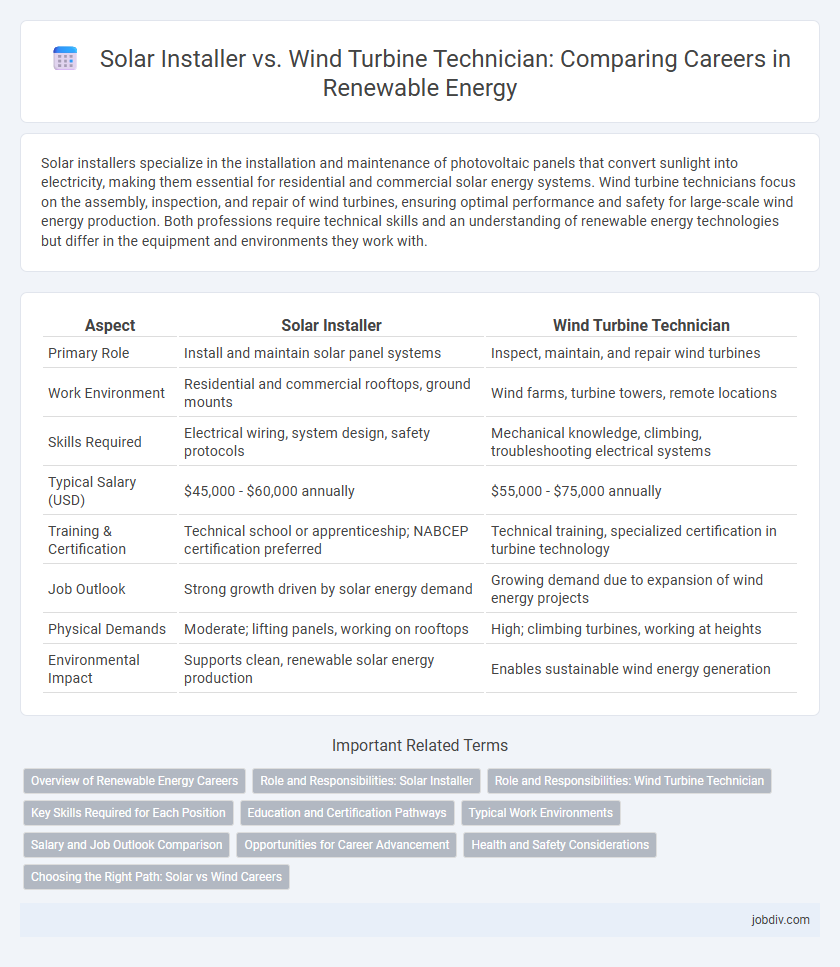Solar installers specialize in the installation and maintenance of photovoltaic panels that convert sunlight into electricity, making them essential for residential and commercial solar energy systems. Wind turbine technicians focus on the assembly, inspection, and repair of wind turbines, ensuring optimal performance and safety for large-scale wind energy production. Both professions require technical skills and an understanding of renewable energy technologies but differ in the equipment and environments they work with.
Table of Comparison
| Aspect | Solar Installer | Wind Turbine Technician |
|---|---|---|
| Primary Role | Install and maintain solar panel systems | Inspect, maintain, and repair wind turbines |
| Work Environment | Residential and commercial rooftops, ground mounts | Wind farms, turbine towers, remote locations |
| Skills Required | Electrical wiring, system design, safety protocols | Mechanical knowledge, climbing, troubleshooting electrical systems |
| Typical Salary (USD) | $45,000 - $60,000 annually | $55,000 - $75,000 annually |
| Training & Certification | Technical school or apprenticeship; NABCEP certification preferred | Technical training, specialized certification in turbine technology |
| Job Outlook | Strong growth driven by solar energy demand | Growing demand due to expansion of wind energy projects |
| Physical Demands | Moderate; lifting panels, working on rooftops | High; climbing turbines, working at heights |
| Environmental Impact | Supports clean, renewable solar energy production | Enables sustainable wind energy generation |
Overview of Renewable Energy Careers
Solar installers focus on the installation and maintenance of photovoltaic panels to harness solar energy, specializing in system design, wiring, and site assessment. Wind turbine technicians maintain and repair wind turbines, emphasizing mechanical, electrical, and hydraulic systems to ensure optimal turbine performance. Both careers play critical roles in advancing renewable energy infrastructure, with strong job growth driven by increasing demand for sustainable power solutions.
Role and Responsibilities: Solar Installer
Solar Installers specialize in assembling, installing, and maintaining solar panel systems on rooftops or ground mounts to optimize energy capture. Their responsibilities include assessing site conditions, securing mounting structures, wiring electrical components, and ensuring compliance with safety and building codes. Precision in installation and knowledge of photovoltaic technology are essential to maximize solar energy production and system durability.
Role and Responsibilities: Wind Turbine Technician
Wind turbine technicians specialize in the installation, maintenance, and repair of wind turbines, ensuring efficient energy production from wind resources. Their responsibilities include inspecting mechanical and electrical components, troubleshooting malfunctions, and performing routine maintenance to maximize turbine performance and safety. These technicians often work at heights and in challenging weather conditions to support sustainable energy infrastructure.
Key Skills Required for Each Position
Solar installers require proficiency in photovoltaic system installation, electrical wiring, and troubleshooting solar panels, along with knowledge of safety protocols and roof work. Wind turbine technicians must possess skills in mechanical maintenance, hydraulic and electrical system repair, and the ability to work at heights while interpreting technical manuals. Both roles demand strong problem-solving abilities and adherence to industry safety standards.
Education and Certification Pathways
Solar installers typically pursue certification through the North American Board of Certified Energy Practitioners (NABCEP), requiring completion of specialized training programs and hands-on experience in photovoltaic system installation. Wind turbine technicians often complete technical education via community college programs or apprenticeships, followed by certification from organizations like the Global Wind Organisation (GWO) that emphasizes safety and operational skills. Both pathways emphasize practical training and industry-recognized credentials to ensure competency in renewable energy system installation and maintenance.
Typical Work Environments
Solar installers primarily work outdoors on rooftops or open fields installing photovoltaic panels, often in residential or commercial settings with varying weather conditions. Wind turbine technicians operate at significant heights on wind turbines, frequently in remote or rural areas with challenging access and exposure to strong winds. Both roles demand physical stamina and safety precautions but differ markedly in the physical environments and risks associated with their specific equipment.
Salary and Job Outlook Comparison
Solar installers earn a median annual wage of around $48,000, with job growth projected at 11% through 2031, driven by expanding solar energy adoption. Wind turbine technicians typically command higher median salaries near $56,000 and face a faster job growth rate of 68%, reflecting increased investment in wind power infrastructure. Both careers benefit from strong demand in renewable energy sectors, but wind turbine technicians generally receive superior compensation and more rapid employment expansion.
Opportunities for Career Advancement
Solar installers benefit from a rapidly growing solar energy market, offering pathways to senior technician roles, project management, and renewable energy consulting. Wind turbine technicians have opportunities for career advancement through specialization in turbine maintenance, supervisory positions, and roles in remote sensing technology and wind farm operations. Both careers provide access to high-demand sectors with evolving technologies, supporting continuous skill development and leadership prospects.
Health and Safety Considerations
Solar installers face risks related to electrical hazards, falls from heights, and heat exposure when working on rooftops, requiring strict adherence to personal protective equipment and fall protection protocols. Wind turbine technicians encounter dangers from confined space entry, high-voltage systems, and extreme weather conditions atop turbines, necessitating specialized training in rescue operations and safety harness use. Both professions demand rigorous health and safety standards to minimize occupational injuries and ensure compliance with OSHA regulations.
Choosing the Right Path: Solar vs Wind Careers
Choosing a career as a solar installer involves mastering photovoltaic system installation and maintenance, with strong demand in residential and commercial sectors. Wind turbine technicians specialize in the upkeep and repair of wind energy systems, requiring skills in electrical and mechanical troubleshooting for large-scale turbines. Job growth projections from the U.S. Bureau of Labor Statistics indicate a 7% increase for solar installers and a faster 68% expansion for wind turbine technicians through 2031, influencing career considerations between innovation in solar technology and the rising prominence of wind energy infrastructure.
Solar Installer vs Wind Turbine Technician Infographic

 jobdiv.com
jobdiv.com